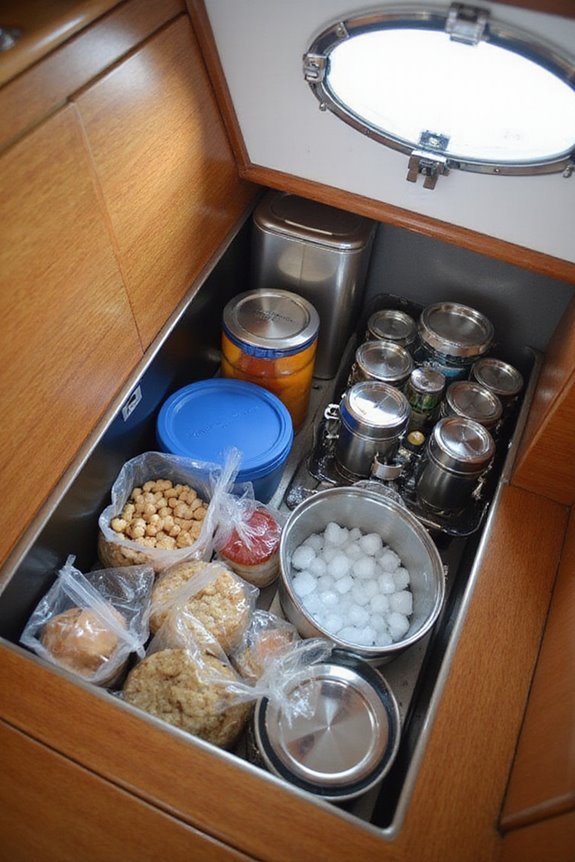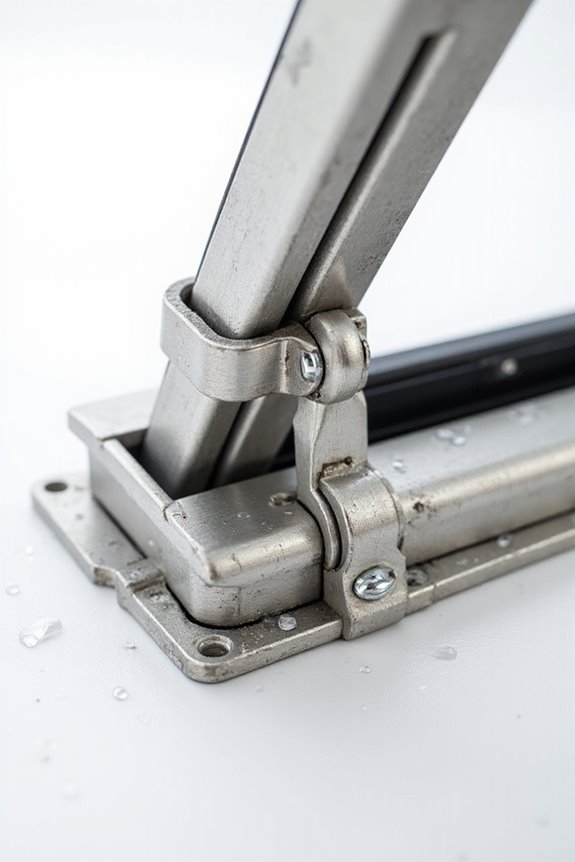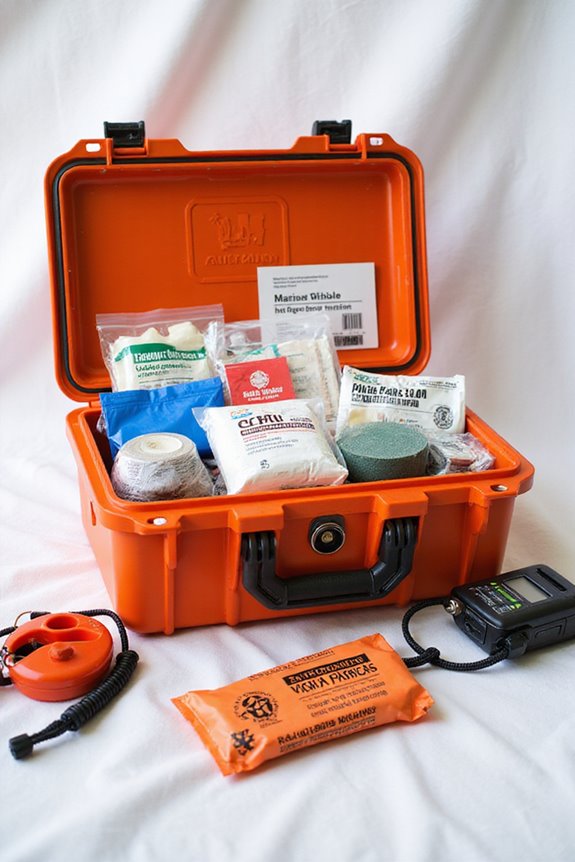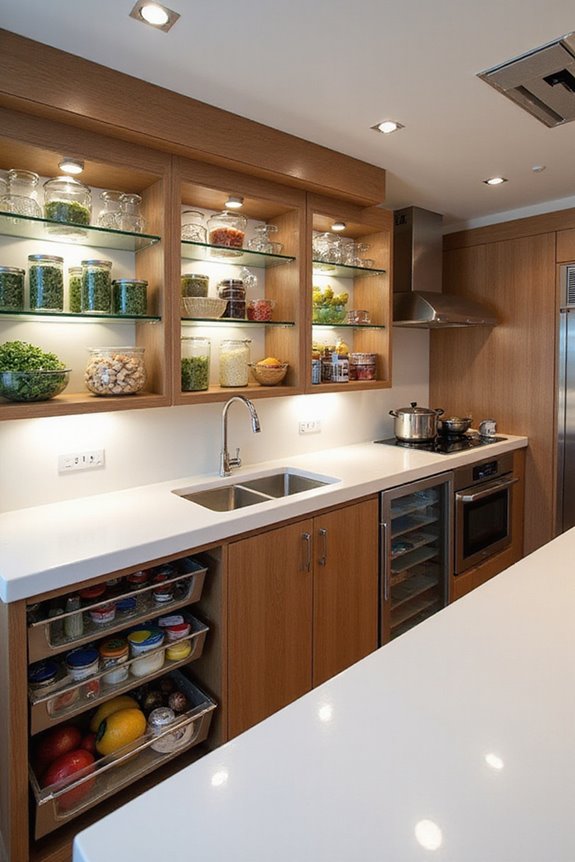When storing food on a boat, we’ve learned to keep things cool, dry, and airtight—think vacuum-sealed meats and stackable, labeled containers to save space and keep pests at bay. Ventilation matters; stale air and humidity are food’s worst enemies, so opening hatches and using reefers or insulated bins helps. Ever tried to keep cans from rolling during rough seas? Lockable latches are a lifesaver! Want to know how to balance nutrition and plan for the long haul? Stick around for some smart tips.
Key Takeaways
- Use vacuum-sealed and airtight containers labeled with dates to extend food freshness and prevent spoilage onboard.
- Store food in cool, shaded, well-ventilated areas to control temperature and minimize humidity exposure during the voyage.
- Employ refrigerated or reefer containers for perishables and stack heavier items on the bottom to maintain stability.
- Plan balanced, versatile meals with non-perishables and fresh fruits to ensure nutrition and flexibility during long trips.
- Regularly inspect for pests and maintain proper food storage hygiene to prevent infestations and ensure onboard safety.
Managing Heat and Humidity on Board
Although managing heat and humidity on a boat might not sound like the most exciting part of boating, it’s absolutely critical if we want our food to stay fresh and tasty. Good heat management starts with smart ventilation—keeping hatches open lets fresh air circulate, preventing that sauna-like feeling below deck. We’re all about finding shaded storage spots for groceries to dodge direct heat, and when possible, using refrigeration or air conditioning makes a huge difference. Humidity control is just as important; aiming for a relative humidity of 30% to 50% helps keep moisture-sensitive foods in good shape. Using hatch covers and thermal barriers stops condensation, while air dryers and dry storage areas keep things from getting damp. Together, these strategies help us beat spoilage and keep our onboard meals enjoyable.
Selecting the Right Containers for Food Storage
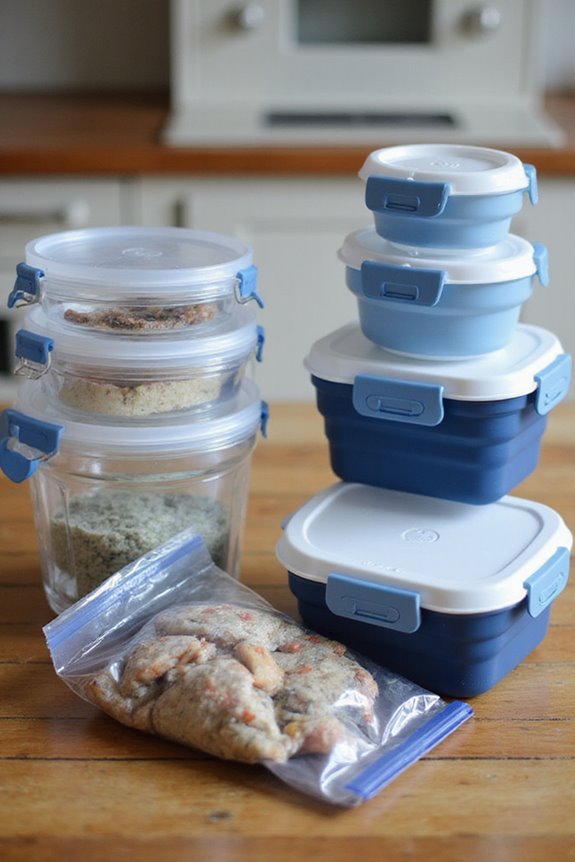
When it comes to keeping our onboard food fresh and safe, picking the right containers is half the battle won. We’ve got various container types to evaluate—reefer containers are great for temperature-sensitive items, maintaining a cool range from -31°F to 80°F. For perishable goods, refrigerated containers with food-grade interiors and strong temperature control systems are our best friends. Ever heard of Controlled Atmosphere (CA) containers? They slow produce ripening, which is handy on longer trips. Don’t fall for dry containers when you need to store perishables—they’re more for snacks and supplies. And let’s not forget insulation; it helps keep temperatures steady and saves energy, so our food stays safe without us burning through power. Choosing wisely means less spoilage, more peace of mind, and more time enjoying the sea.
Maximizing Space Efficiency in Limited Storage Areas
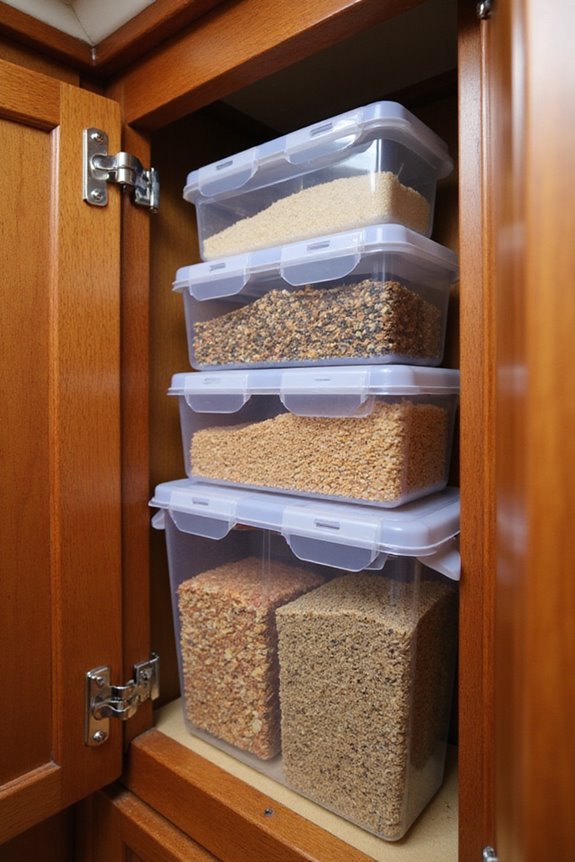
Since space on a boat is always limited, making every inch count becomes a bit of an art form. We rely on clever space saving techniques like vertical storage—stackable containers are our best friends, letting us pile goods neatly upward without toppling chaos. Ever tried stacking canned goods along a locker’s edge? It’s surprisingly effective and keeps things tidy. But remember, heavier items belong at the bottom for stability; no one wants cans flying mid-wave! We also fit square containers snugly to avoid wasted horizontal space, and adjustable shelves help maximize every nook. Labeling stacks isn’t just neat—it stops the “What’s in here?” mystery. By using vertical storage smartly, we turn tiny boat pantries into efficient, accessible food hubs, making boat life a bit easier and more enjoyable for everyone onboard.
Protecting Food From Motion and Water Exposure
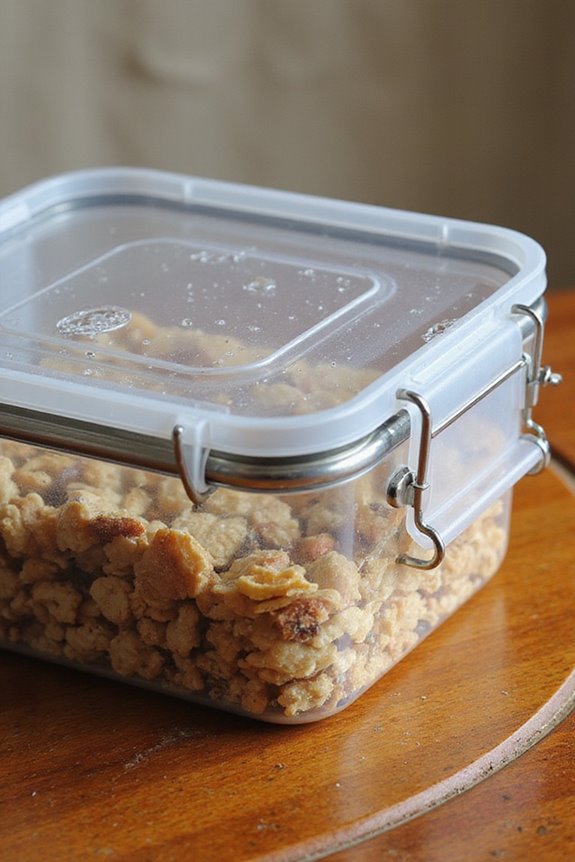
Even though boat storage areas can be cozy, keeping our food safe from both the constant motion and sneaky water exposure is an essential challenge we can’t ignore. For motion stabilization, let’s rely on gimballed appliances—they keep stoves steady, so no surprise kitchen catastrophes. Lockable latches on cupboards or drawers are lifesavers, stopping everything from tumbling out when waves hit. Using airtight, secure containers cushioned with foam or cloth adds extra security. Now, about those pesky water threats: waterproof solutions like sealed containers and Ziplock bags protect our food from moisture creeping in. Dry storage areas with good ventilation keep humidity low, while silica packs quietly absorb any lurking dampness. By combining smart motion control and waterproof efforts, we can enjoy our meals without worrying about spills or soggy snacks on deck. Who’s in?
Organizing Canned and Dry Goods for Longevity
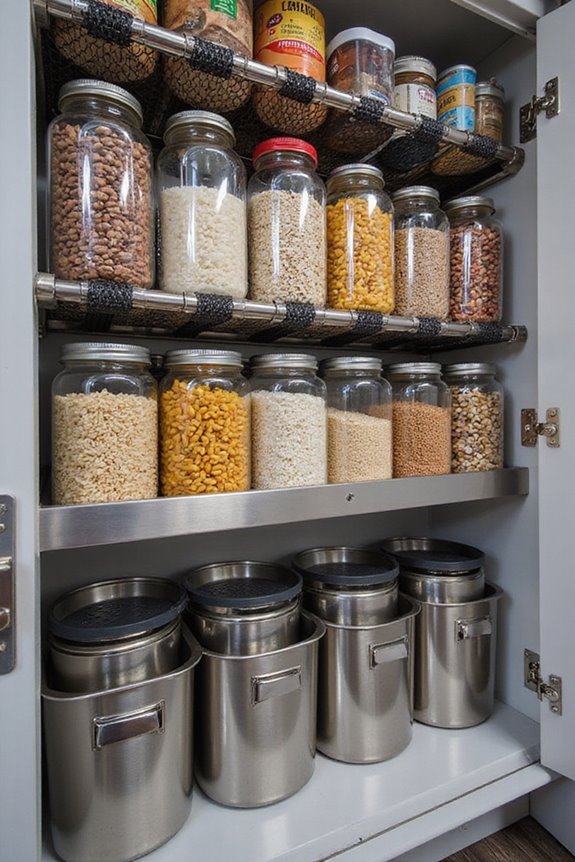
Although organizing food on a boat might sound straightforward, keeping canned and dry goods fresh and secure takes a bit of savvy planning. We always store canned goods low and centrally to maintain balance—after all, those cans aren’t exactly feather-light. Using plastic bins with lids helps protect them from salt spray and that sneaky water leakage that loves to cause rust. Speaking of rust, a little superficial rust isn’t scary, but heavy rust? That’s a red flag we don’t ignore. For dry storage, ditching cardboard for airtight containers or ziplock bags keeps moisture and bugs at bay. Plus, adding silica packets really does wonders. Labeling everything makes our voyages smoother—no one wants to hunt for half a bag of rice at sea! Organizing smartly really extends the shelf life and keeps our galley happy.
Strategies for Storing Fresh Produce and Perishables
When it comes to storing fresh produce and perishables on a boat, we’ve learned it’s as much about strategy as it is about space. We use secure bins and nets to keep items like fresh herbs safe from bruising caused by waves. Ever tried produce rotation? It’s our secret weapon—using older veggies first to reduce waste and keep everything fresh. Room temperature storage is another neat trick: tomatoes, for example, last longer if we keep them stem-side down. Managing ethylene gas is key too, so we separate bananas from other fruits to avoid premature ripening. And don’t forget a cool, dark spot for potatoes and onions—away from each other! Trust us, with these strategies, you’ll have crisp, tasty produce even on the choppiest seas.
Ensuring Safety Through Regular Inspection and Maintenance
Someone’s got to keep an eye on the safety of our food storage – why not us? Regular inspection routines are key to preventing spoiled food and disappointing meals on the water. We recommend using maintenance checklists to track cooler conditions, checking for cracks, ensuring watertight seals, and confirming ice levels stay below 40°F. Don’t forget to examine canned goods for rust and toss anything questionable. Keeping our food safe isn’t just about storing it right; it’s a continuous process. We’re in this together, so let’s make regular checks part of our boating routine. After all, a well-maintained cooler means tasty meals and fewer worries—who wants to deal with stinky leftovers out at sea? Let’s keep our inspections sharp and our food safer.
Adapting Storage Methods for Cruising Conditions
Since cruising conditions can throw all sorts of challenges our way, adapting how we store food becomes essential for keeping meals fresh and tasty on board. We’ve got to manage temperature and humidity carefully—freezers at -18°C, dry storage dry as a desert. Ever tried eating soggy crackers? Not fun. Using various preservation techniques like vacuum-sealing, canning, or even dehydrating helps us stretch our supplies smartly. Bulk purchasing is our friend too, letting us stock up while saving space and money, but only if we organize well and rotate food properly to avoid waste. Securing containers against the boat’s motion? Absolutely. It may sound like a puzzle, but with a bit of planning, we keep our galley ready, meals delicious, and spirits high no matter the seas.
Implementing Pest Control in Marine Environments
Although pest control might not be the most glamorous part of boating life, keeping unwanted critters off our vessel is absolutely essential for preserving food quality and overall hygiene. We all face unique marine pest challenges—limited space, humidity, and easy pest access can make things tricky. So, what are some effective pest prevention strategies? Sealing storage compartments tightly, using airtight containers, and regularly inspecting those nooks and crannies go a long way. Ever tried rodent traps or air curtains? They’re surprisingly effective at keeping pests out without harsh chemicals. Plus, using lighting to highlight access points helps deter those uninvited guests. Together, by staying vigilant and adopting integrated pest measures, we protect not only our food but our floating home’s comfort and safety. Who knew pest control could be this satisfying?
Planning Provisions for Extended Voyages
Now that we’ve tackled keeping pesky critters off our food, let’s talk about what happens when we’re heading out for a longer stretch at sea. Planning provisions for extended voyages means smart food sourcing—like stocking up on long-lasting staples such as rice, beans, and canned goods at ports where prices are friendlier. Vacuum-sealing meats and veggies keeps them fresher, preventing freezer burn, which is a win for our taste buds and storage space. Meal versatility is key too—choosing ingredients that can work in multiple dishes helps keep menus flexible and prep simple. Plus, hardy fruits like apples and oranges can last well over a week, giving us some fresh options. So, ready to pack smart and eat well, even when miles from shore?
Frequently Asked Questions
How Do I Safely Dispose of Spoiled Food on Board?
When handling food waste disposal, we always use approved disposal methods, ensuring spoiled food is securely stored and documented. Together, we can protect the oceans by following regulations and minimizing our environmental impact while afloat.
Can I Store Homemade Preserves or Pickles on a Yacht?
It is understood you might worry about pickle safety on a yacht, but with proper sealing and cool storage, homemade preserves can thrive. By managing preserve shelf life carefully, we all enjoy delicious, safe flavors while sailing together.
What Are Best Practices for Stocking Emergency Rations?
When stocking emergency kits, let’s choose varied ration types like canned goods, dried fruits, and ready-to-eat meals. We’ll prioritize long shelf life, nutrition, and compactness to keep us safe and prepared together.
How Often Should I Rotate Canned Goods on a Yacht?
Like clockwork, we make sure our canned goods see regular storage rotation—ideally every few months—to keep our supplies fresh and safe. This steady rhythm helps us stay prepared and connected as a crew.
Are There Specific Foods to Avoid Bringing on Long Boating Trips?
We’ve found that avoiding perishable items and foods with high moisture helps us keep things fresh and mess-free on extended trips. Let’s stick to durable snacks and low-moisture foods for a smoother boating experience together.

